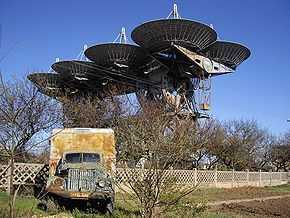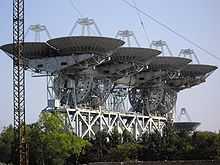Pluton (complex)
Coordinates: 45°10′13.18″N 33°15′11.18″E / 45.1703278°N 33.2531056°E
| Pluton | |
|---|---|
 ADU-1000. Transmitter. South station.[1] | |
| Organization | Center for Deep Space Communications |
| Location | Yevpatoria, Crimea, Ukraine. |
| Wavelength | radio 8 sm, 30...40 sm |
| Built | 1960 |
| Telescope style | reflector |
| Diameter | consisted of eight (8) 16 meter dishes |
| Collecting area | ≈900 m² |
| Dome | none |
| Website | http://www.spacecenter.gov.ua |


Pluton (at 1980ss – Pluton-M) is a system of deep space communications and a planetary radar. It was built near Yevpatoria in 1960, and consists of at least three antennas. Three of them are of the ADU-1000 design, an assembly of eight mirrors, each with diameter of 16 meters. At the North station,[1] two receiver antennas were built, and a transmitter was constructed 8.5 kilometers away at the South station.[2] Each receiving dish has a Cassegrain system with subreflectors mounted on quadrapods in front of the dishes.[3] The dishes were placed on two hull of diesel submarines, welded together and laid down on the railway bridge trusses. The antennas of ADU-1000 were mounted on steerable frames constructed from battleship gun turrets and railway bridge trusses.[2]
The Pluton complex supported all the Soviet space programs until 1978, when the Yevpatoria RT-70 radio telescope was built. The Pluton complex was the world's highest capacity deep space communication system prior to Goldstone in 1966.
In 1961 it performed one of the world's first radiolocations of the planet Venus. In June 1962 it performed the world's first successful radiolocation of the planet Mercury. In February 1963 it performed successful radiolocation of the planet Mars. In September–October 1963 it performed successful radiolocation of the planet Jupiter.
On 19 and 24 November 1962, the words «MIR», «LENIN», and «SSSR» were sent in the direction of the star HD131336 in the constellation Libra. These message (The Morse Message (1962)[4]) are the first radio broadcasts for extraterrestrial civilizations in the history of mankind.[5]
November 11, 2013 one of the three antennas dismantled.[6]
Missions
As Deep space communication system:
- Venera-1,-2,-3,-4,-5,-6.-7.-9,-10,-11,-12
- Mars-2,-3,-4,-5,-6,-7
- 1995–2000 – Interball-1
- November 16, 1996 – Mars 96.
As Planetary radar:
- 1961 April 18 and 26 – the world's first successful radiolocation of the planet Venus.
- June 1962, after increasing the sensitivity of the receiving equipment – the world's first radiolocation of the planet Mercury.
- October–November 1962 – second radar study of Venus.
- February 1963 – radiolocation of the planet Mars.
- September–October 1963 – radiolocation of the planet Jupiter.
Radioastronomy:
- April 1964 – study Crab Nebula
- 2004 – study coronal holes.
References
- ↑ 1.0 1.1 Sven Grahn. Yevpatoria - as the U.S. saw it in the 1960s
- ↑ 2.0 2.1 Don P. Mitchel. Soviet Telemetry Systems. Deep-Space Communication Centers.
- ↑ Sven Grahn. ADU-1000 antennas at Yevpatoria.
- ↑ An Awkward History of Our Space Transmissions
- ↑ "MIR, LENIN, SSSR"
- ↑ Последние дни АДУ-1000